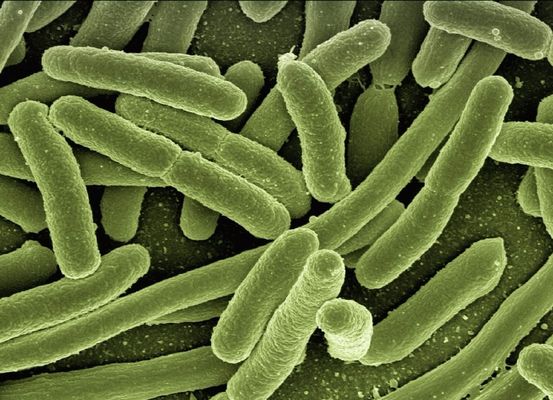4.2.5
Surface Area to Volume Ratio
Surface Area to Volume Ratio
Surface Area to Volume Ratio
The surface area to volume ratio influences how substances and heat energy can be transferred around multicellular organisms.
 2.4.1.1 - Surface area to volume ratio,h_400,q_80,w_640.png)
 2.4.1.1 - Surface area to volume ratio,h_400,q_80,w_640.png)
Surface area
Surface area
- The surface area of an organism is the total surface over which substances and heat can be exchanged.
- Surface area alone cannot influence the rate of exchange.
- The surface area of an organism relative to their volume is more important.
 2.4.1.1 - Surface area to volume ratio,h_400,q_80,w_640.png)
 2.4.1.1 - Surface area to volume ratio,h_400,q_80,w_640.png)
Volume
Volume
- The volume of an organism determines the number of substances that need to be taken in and transported out.
- As the volume increases, more materials are needed for metabolism because there are more cells.
 2.4.1.1 - Surface area to volume ratio,h_400,q_80,w_640.png)
 2.4.1.1 - Surface area to volume ratio,h_400,q_80,w_640.png)
Surface area to volume ratio
Surface area to volume ratio
- When an organism increases in size, its volume increases because there are more cells.
- The increase in the number of cells means that there is less surface area for the exchange of materials because many cells are in contact with one another.
- The surface area to volume ratio (SA : V) decreases with increasing organism size.
Exchange
Exchange
Single-celled organisms exchange directly with their external environment. Multicellular organisms need adaptions to sufficiently exchange materials with the environment.


Need for exchange
Need for exchange
- Single-celled organisms need to obtain substances from their environment to be used in processes inside the cell (e.g. oxygen for respiration).
- Waste substances also need to be removed from the cell (e.g. carbon dioxide) to avoid harming the cell.
- Substances are exchanged by all organisms for this reason.
- So, the surface area of the plasma membrane needs to be sufficiently large enough to adequately exchange useful substances and waste.


Body surface exchange
Body surface exchange
- Single-celled organisms can exchange gasses and other substances using their cell membrane.
- The rate of gas exchange is increased by a larger surface area to volume ratio.
- Single-celled organisms can be adapted to increase their surface area to volume ratio (e.g. by making themselves wide, flat or with multiple folds).


Diffusion rate
Diffusion rate
- Diffusion rate is rapid for single-celled organisms because the substances only have to move across one cell-surface membrane.


Larger organisms
Larger organisms
- As cells or organisms increase in size, their surface area to volume ratio decreases.
- This decreases the rate of exchange with the environment.
- This means larger cells and multicellular organisms need adaptions to allow the effective exchange of materials with the environment.
- Examples of adaptions included having highly folded membranes to increase the surface area to volume ratio.
1Cell Structure
1.1Cell Structure
1.1.1Studying Cells - Microscopes
1.1.2Introduction to Eukaryotic & Prokaryotic Cells
1.1.3Ultrastructure of Eukaryotic Cells
1.1.4Ultrastructure of Eukaryotic Cells 2
1.1.5Ultrastructure of Eukaryotic Cells 3
1.1.6Prokaryotic Cells
1.1.7Viruses
1.1.8End of Topic Test - Cell Structure
1.1.9Exam-Style Question - Microscopes
1.1.10A-A* (AO2/3) - Cell Structure
2Biological Molecules
2.1Testing for Biological Modules
2.2Carbohydrates & Lipids
2.3Proteins
3Enzymes
4Cell Membranes & Transport
4.1Biological Membranes
5The Mitotic Cell Cycle
6Nucleic Acids & Protein Synthesis
6.1Nucleic Acids
7Transport in Plants
8Transport in Mammals
8.1Circulatory System
8.2Transport of Oxygen & Carbon Dioxide
9Gas Exchange
9.1Gas Exchange System
10Infectious Diseases
10.1Infectious Diseases
10.2Antibiotics
11Immunity
12Energy & Respiration (A2 Only)
13Photosynthesis (A2 Only)
14Homeostasis (A2 Only)
14.1Homeostasis
14.2The Kidney
14.3Cell Signalling
14.4Blood Glucose Concentration
14.5Homeostasis in Plants
15Control & Coordination (A2 Only)
15.1Control & Coordination in Mammals
15.1.1Neurones
15.1.2Receptors
15.1.3Taste
15.1.4Reflexes
15.1.5Action Potentials
15.1.6Saltatory Conduction
15.1.7Synapses
15.1.8Cholinergic Synnapses
15.1.9Neuromuscular Junction
15.1.10Skeletal Muscle
15.1.11Sliding Filament Theory Contraction
15.1.12Sliding Filament Theory Contraction 2
15.1.13Menstruation
15.1.14Contraceptive Pill
15.2Control & Co-Ordination in Plants
16Inherited Change (A2 Only)
16.1Passage of Information to Offspring
16.2Genes & Phenotype
17Selection & Evolution (A2 Only)
17.2Natural & Artificial Selection
18Classification & Conservation (A2 Only)
18.1Biodiversity
18.2Classification
19Genetic Technology (A2 Only)
19.1Manipulating Genomes
19.2Genetic Technology Applied to Medicine
19.3Genetically Modified Organisms in Agriculture
Jump to other topics
1Cell Structure
1.1Cell Structure
1.1.1Studying Cells - Microscopes
1.1.2Introduction to Eukaryotic & Prokaryotic Cells
1.1.3Ultrastructure of Eukaryotic Cells
1.1.4Ultrastructure of Eukaryotic Cells 2
1.1.5Ultrastructure of Eukaryotic Cells 3
1.1.6Prokaryotic Cells
1.1.7Viruses
1.1.8End of Topic Test - Cell Structure
1.1.9Exam-Style Question - Microscopes
1.1.10A-A* (AO2/3) - Cell Structure
2Biological Molecules
2.1Testing for Biological Modules
2.2Carbohydrates & Lipids
2.3Proteins
3Enzymes
4Cell Membranes & Transport
4.1Biological Membranes
5The Mitotic Cell Cycle
6Nucleic Acids & Protein Synthesis
6.1Nucleic Acids
7Transport in Plants
8Transport in Mammals
8.1Circulatory System
8.2Transport of Oxygen & Carbon Dioxide
9Gas Exchange
9.1Gas Exchange System
10Infectious Diseases
10.1Infectious Diseases
10.2Antibiotics
11Immunity
12Energy & Respiration (A2 Only)
13Photosynthesis (A2 Only)
14Homeostasis (A2 Only)
14.1Homeostasis
14.2The Kidney
14.3Cell Signalling
14.4Blood Glucose Concentration
14.5Homeostasis in Plants
15Control & Coordination (A2 Only)
15.1Control & Coordination in Mammals
15.1.1Neurones
15.1.2Receptors
15.1.3Taste
15.1.4Reflexes
15.1.5Action Potentials
15.1.6Saltatory Conduction
15.1.7Synapses
15.1.8Cholinergic Synnapses
15.1.9Neuromuscular Junction
15.1.10Skeletal Muscle
15.1.11Sliding Filament Theory Contraction
15.1.12Sliding Filament Theory Contraction 2
15.1.13Menstruation
15.1.14Contraceptive Pill
15.2Control & Co-Ordination in Plants
16Inherited Change (A2 Only)
16.1Passage of Information to Offspring
16.2Genes & Phenotype
17Selection & Evolution (A2 Only)
17.2Natural & Artificial Selection
18Classification & Conservation (A2 Only)
18.1Biodiversity
18.2Classification
19Genetic Technology (A2 Only)
19.1Manipulating Genomes
19.2Genetic Technology Applied to Medicine
19.3Genetically Modified Organisms in Agriculture
Unlock your full potential with Seneca Premium
Unlimited access to 10,000+ open-ended exam questions
Mini-mock exams based on your study history
Unlock 800+ premium courses & e-books